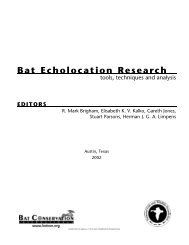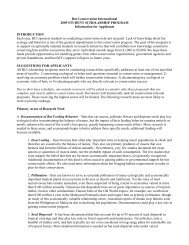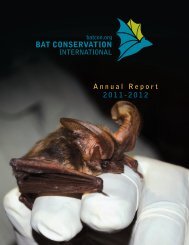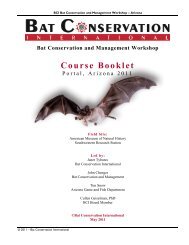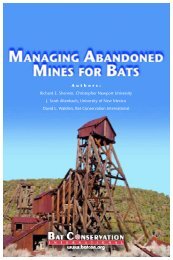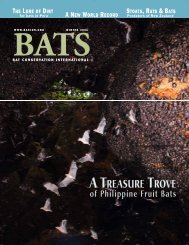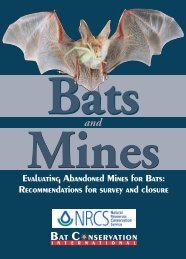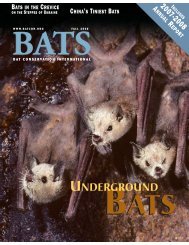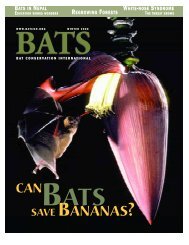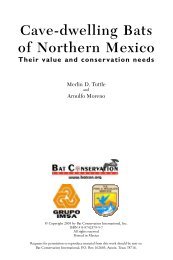OLD BATS OLD BATS - Bat Conservation International
OLD BATS OLD BATS - Bat Conservation International
OLD BATS OLD BATS - Bat Conservation International
You also want an ePaper? Increase the reach of your titles
YUMPU automatically turns print PDFs into web optimized ePapers that Google loves.
© MERLIN D. TUTTLE, BCI / 8185400<br />
Lesser long-nosed bats are critical pollinators of many<br />
desert plants. This one’ is feeding on the fruit of a<br />
saguaro cactus.<br />
This is a particularly endearing creature, says Ronnie Sidner, a<br />
research associate and adjunct instructor in the Department of<br />
Ecology and Evolutionary Biology at the University of Arizona.<br />
“The fur is soft and smooth, and they look adorably inquisitive<br />
because of their big brown eyes,” she said.<br />
Since roughly 10 percent of the fort’s 70,000 acres are studded<br />
with agave, it seemed likely the endangered bat would visit the<br />
base, but almost no historical data were available. In 1990, the fort<br />
utilized part of a Department of Defense contract with an environmental<br />
consulting firm in Tucson to locate, monitor, count and protect<br />
bats. Sidner, a bat biologist, was charged with determining<br />
when, where and how many bats are present.<br />
For the first five years, no lesser long-nosed bats were recorded,<br />
and only one was spotted in 1995. By 2000, however, 3,180 bats<br />
were counted. By 2005, the total had reached about 14,000,<br />
Sidner said.<br />
Fort Huachuca contains three known lesser long-nosed bat<br />
roosts – two caves used as day roosts and one as a night roost. To<br />
conduct her census, Sidner stands just outside the roost entrances<br />
with infrared lights and night-vision gear. <strong>Bat</strong>s are recorded on<br />
video, then Sidner goes frame-by-frame counting the bats present.<br />
The lesser long-nosed bat is but one of 11 species documented<br />
on the post, and Fort Huachuca has implemented a variety of steps<br />
to protect their roosts, minimize disturbances and ensure a healthy<br />
population of both agave and lesser long-nosed bats, said Wildlife<br />
COURTESY OF GRANT NULLE, FORT<br />
Sgt.1st Class Rodrigo Fernandez, a game warden with the Fort<br />
Huachuca Military Police, helps protect lesser long-nosed bats<br />
within a protected natural area.<br />
Volume 25, No. 2 SUMMER 2006 5 <strong>BATS</strong>




